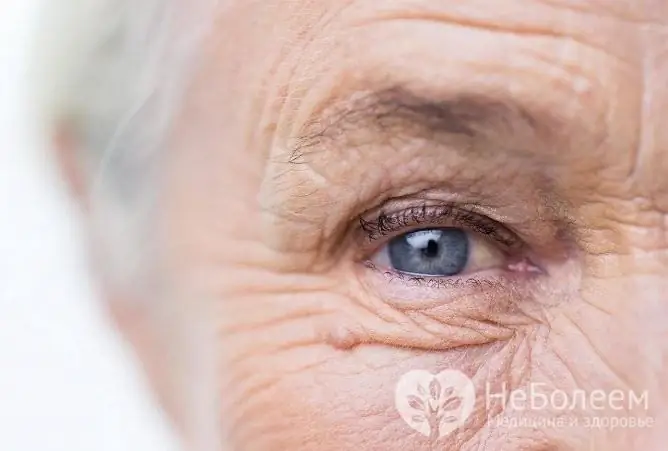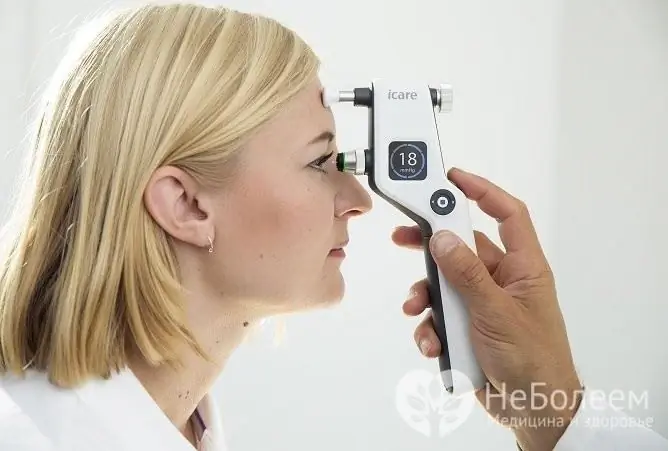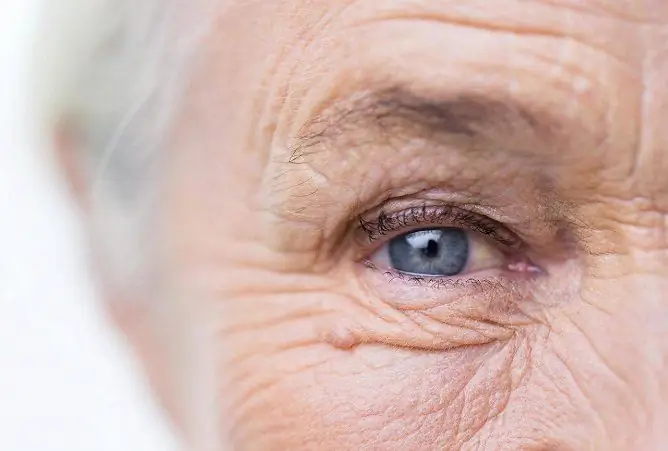- Author Rachel Wainwright [email protected].
- Public 2023-12-15 07:39.
- Last modified 2025-11-02 20:14.
The norm of eye pressure in women after 60 years of age and at an earlier age
The content of the article:
- What should be the normal intraocular pressure in a person
- Methods for measuring intraocular pressure
- Intraocular pressure abnormalities
- Video
The norm of ocular pressure (IOP) is a range of values beyond which it can indicate the development of a number of diseases.
Normally, about two cubic millimeters of fluid enters the eye every minute, about the same volume flows out. However, with the development of some pathological processes, fluid can be retained in the eye, and intraocular pressure can decrease or increase. Slight fluctuations in intraocular pressure can normally be observed during the day, but the difference usually does not exceed 3 mm Hg. Art.

Persistently high intraocular pressure, especially in old age, may indicate glaucoma
If signs appear that suggest a significant change in the level of intraocular pressure, you should seek medical help, since some diseases that are characterized by this pathological condition require immediate treatment in order to avoid the development of irreversible consequences. The patient is examined with the measurement of the necessary ophthalmic parameters and the examination of the fundus, after which the treatment can be selected.
What should be the normal intraocular pressure in a person
Intraocular pressure of 10 to 20 mm Hg is considered normal in children and adults under 40. Art.
With age, the level of intraocular pressure usually increases slightly for physiological reasons. In addition, the norm of eye pressure in women after 50 years has a higher upper limit, since this indicator increases in postmenopausal women, which is associated with hormonal changes in the body.
The intraocular pressure norms for different age groups of patients over 40 are presented in the table.
Table. Intraocular pressure rate by age
| Age | Intraocular pressure, mm Hg Art. |
| 40-50 years | 10-23 |
| 50-60 years old | 23-25 |
| 60-70 years and older | 23-26 |
The range of intraocular pressure, which is considered normal, is the same in men and women. The norm of eye pressure at 60 years of age and after practically does not differ from that of older patients.
Since the norm of eye pressure at 50 years of age and older is somewhat higher than at a younger age, an increased rate usually does not require correction, but it serves as a reason for regular medical examinations, as it may indicate developing glaucoma. Persons aged 50-55 years and older are recommended to undergo a preventive examination by an ophthalmologist at least once a year.
Methods for measuring intraocular pressure
An experienced ophthalmologist is able to give a rough estimate of intraocular pressure without tools by palpating the patient's eyeball through the eyelids.
Several techniques are used to accurately measure intraocular pressure. Non-contact tonometry is widespread. This method is based on the assessment of the flattening of the cornea by air flow. Basically, non-contact tonometry is used for screening, and not for the management of patients with glaucoma, as it provides an inaccurate result.
Four measurements are made in one study. This number of measurements is sufficient to obtain an average value that can be used for diagnostic purposes. When determining intraocular pressure by this method, using a Goldmann tonometer or ICare, 9-21 mm Hg is normal for people under 40. Art.
The advantages of the ICare contact method include the portability of the tonometer and the possibility of using it to measure intraocular pressure in children of different ages without the need for anesthesia. In addition, the ICare tonometer is convenient for self-monitoring of eye pressure at home. The main disadvantage of the device is its high price.
To measure intraocular pressure, the Maklakov tonometry method is actively used. What is the normal pressure for this method? Since its difference is the displacement of a larger volume of fluid from the eye chambers, the normal range in the age group up to 40 years is 12-25 mm Hg. Art. Maklakov tonometry is considered to be a fairly accurate and reliable technique with minimal dependence on the researcher.
The spread in the values of intraocular pressure can be a consequence of measuring it by different methods. It should be remembered that it is impossible to compare the results of measuring intraocular pressure, obtained during the study by different methods, since they use different norms. If it is necessary to monitor the pressure inside the eye in dynamics (especially for patients with glaucoma), it is recommended to always measure it by any one method.

Portable blood pressure monitor ICare provides a fairly high accuracy of measurements at home
Intraocular pressure abnormalities
A decrease in intraocular pressure is observed quite rarely, much more often doctors have to deal with its increase. The risk of developing pathology increases with age; most often, increased intraocular pressure is diagnosed in patients over 45 years old.
High numbers of intraocular pressure are observed in glaucoma, arterial hypertension, severe fatigue, heart failure, hypothyroidism, poisoning, kidney disease.
An increase in intraocular pressure can be of several types:
- transient - the indicator goes beyond the normal range for a short time, intraocular pressure usually normalizes on its own and does not require treatment;
- labile - intraocular pressure sometimes rises, then returns to normal, while the jumps are often regular;
- stable - indicates glaucoma or a high risk of its development.
Increased intraocular pressure is manifested by a deterioration in vision, a reduction in the field of vision, redness of the eyes, headache, pain in the eyes, flickering of flies and / or rainbow circles in front of the eyes, a feeling of fullness in the eyes. With such a deviation of the eye pressure from the norm, compression of the optic nerve is possible, if this happens often, then it leads to its atrophy and is fraught with complete loss of vision.
A decrease in intraocular pressure is observed in trauma, eye surgery, low blood pressure, infectious and inflammatory processes, dehydration, retinal detachment, anomalies of the eyeball, kidney disease, endocrine pathologies.
With a decrease in intraocular pressure, the patient experiences pain in the eyes, redness, dryness, irritation, a feeling of the presence of a foreign body in the eye, and rapid eye fatigue. Slightly lowered intraocular pressure is usually asymptomatic.
In order to prevent deviations of intraocular pressure from the norm, it is necessary to adhere to proper nutrition, ensure adequate physical activity, give up bad habits, have sufficient night's sleep, and avoid physical and mental stress. Patients at risk are recommended to be monitored by an ophthalmologist. How many times a year you need to be examined depends on the pathology detected.
Video
We offer for viewing a video on the topic of the article.

Anna Kozlova Medical journalist About the author
Education: Rostov State Medical University, specialty "General Medicine".
Found a mistake in the text? Select it and press Ctrl + Enter.






